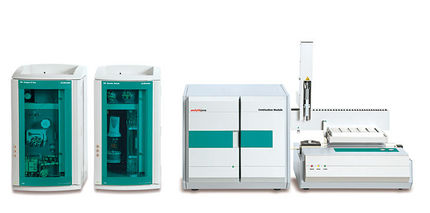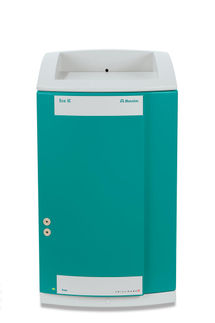Carbon (C)
Standard atomic mass: 12.0107(8) u
Table
nuclide
symbol
| Z(p)
| N(n)
|
isotopic mass (u)
| half-life
| nuclear
spin
| representative
isotopic
composition
(mole fraction)
| range of natural
variation
(mole fraction)
|
| excitation energy
|
| 8C
| 6
| 2
| 8.037675(25)
| 2.0(4) x 10-21 s [230(50) keV]
| 0+
|
|
|
| 9C
| 6
| 3
| 9.0310367(23)
| 126.5(9) ms
| (3/2-)
|
|
|
| 10C
| 6
| 4
| 10.0168532(4)
| 19.290(12) s
| 0+
|
|
|
| 11C
| 6
| 5
| 11.0114336(10)
| 20.334(24) min
| 3/2-
|
|
|
| 12C
| 6
| 6
| 12 by definition
| STABLE
| 0+
| 0.9893(8)
| 0.98853-0.99037
|
| 13C
| 6
| 7
| 13.0033548378(10)
| STABLE
| 1/2-
| 0.0107(8)
| 0.00963-0.01147
|
| 14C
| 6
| 8
| 14.003241989(4)
| 5.70(3) x 103 years
| 0+
|
|
|
| 15C
| 6
| 9
| 15.0105993(9)
| 2.449(5) s
| 1/2+
|
|
|
| 16C
| 6
| 10
| 16.014701(4)
| 0.747(8) s
| 0+
|
|
|
| 17C
| 6
| 11
| 17.022586(19)
| 193(5) ms
| (3/2+)
|
|
|
| 18C
| 6
| 12
| 18.02676(3)
| 92(2) ms
| 0+
|
|
|
| 19C
| 6
| 13
| 19.03481(11)
| 46.2(23) ms
| (1/2+)
|
|
|
| 20C
| 6
| 14
| 20.04032(26)
| 16(3) ms [14(+6-5) ms]
| 0+
|
|
|
| 21C
| 6
| 15
| 21.04934(54)#
| <30 ns
| (1/2+)#
|
|
|
| 22C
| 6
| 16
| 22.05720(97)#
| 6.2(13) ms [6.1(+14-12) ms]
| 0+
|
|
|
Notes
- The precision of the isotope abundances and atomic mass is limited through variations. The given ranges should be applicable to any normal terrestrial material.
- Values marked # are not purely derived from experimental data, but at least partly from systematic trends. Spins with weak assignment arguments are enclosed in parentheses.
- Uncertainties are given in concise form in parentheses after the corresponding last digits. Uncertainty values denote one standard deviation, except isotopic composition and standard atomic mass from IUPAC which use expanded uncertainties.
Palaeo-climate
12C and 13C can be used as temperature tracers that explain ocean circulation. Plants find it easier to use the lighter isotopes (12C) when they convert sunlight and carbon dioxide into food , thus large blooms of plankton (free-floating organisms) draw large amounts of 12C into the oceans. If those oceans are stratified (layers of warm water near the top, and icy water deeper down) the water cannot circulate, thus when the plankton dies it sinks and carries 12C with them, making the surface layers relatively rich in 13C. Where the cold waters well up from the depths (North Atlantic) it carries the 12C with it. Thus, when the ocean was less stratified than today, there was plenty of 12C in the skeletons of surface-dwelling species. Other indicators of past climate include the prescence of tropical species, coral growths rings, etc. (Flannery, 2005)
References
- Flannery, T 2005, The weather makers: the history & future of climate change, The Text Publishing Company, Melbourne, Australia. ISBN 1920885 84 6.
- Isotope masses from Ame2003 Atomic Mass Evaluation by G. Audi, A.H. Wapstra, C. Thibault, J. Blachot and O. Bersillon in Nuclear Physics A729 (2003).
- Isotopic compositions and standard atomic masses from Atomic weights of the elements. Review 2000 (IUPAC Technical Report). Pure Appl. Chem. Vol. 75, No. 6, pp. 683-800, (2003) and Atomic Weights Revised (2005).
- Half-life, spin, and isomer data selected from these sources. Editing notes on this article's talk page.
- Audi, Bersillon, Blachot, Wapstra. The Nubase2003 evaluation of nuclear and decay properties, Nuc. Phys. A 729, pp. 3-128 (2003).
- National Nuclear Data Center, Brookhaven National Laboratory. Information extracted from the NuDat 2.1 database (retrieved Sept. 2005).
- David R. Lide (ed.), Norman E. Holden in CRC Handbook of Chemistry and Physics, 85th Edition, online version. CRC Press. Boca Raton, Florida (2005). Section 11, Table of the Isotopes.
See also
|







